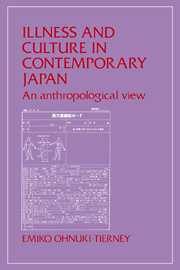Book contents
- Frontmatter
- Contents
- List of illustrations
- Acknowledgments
- 1 Introduction
- Part I Basic concepts and attitudes toward health and illness
- Part II Medical pluralism
- 5 Kanpō: Traditional Japanese medicine of Chinese origin
- 6 Medical roles of Japanese religions: A descriptive overview
- 7 Medical roles of Japanese religions: A historical-symbolic interpretation
- 8 Doctors and outpatients: Biomedicine (I)
- 9 Hospitalization: Biomedicine (II)
- 10 Medical pluralism
- Summary
- References
- Index
8 - Doctors and outpatients: Biomedicine (I)
Published online by Cambridge University Press: 12 January 2010
- Frontmatter
- Contents
- List of illustrations
- Acknowledgments
- 1 Introduction
- Part I Basic concepts and attitudes toward health and illness
- Part II Medical pluralism
- 5 Kanpō: Traditional Japanese medicine of Chinese origin
- 6 Medical roles of Japanese religions: A descriptive overview
- 7 Medical roles of Japanese religions: A historical-symbolic interpretation
- 8 Doctors and outpatients: Biomedicine (I)
- 9 Hospitalization: Biomedicine (II)
- 10 Medical pluralism
- Summary
- References
- Index
Summary
This chapter focuses on the sociocultural aspects of biomedical practice in Japan. The delivery of biomedicine in Japan is embedded in Japanese culture and society, which render it radically different from biomedicine as it is practiced in other societies. This chapter, then, is not about biomedical science itself.
Although the word “biomedicine” is used for the subtitle of this chapter and the next because the majority of licensed doctors and hospitals deliver biomedicine, the description applies equally well to those kanpō doctors who must be licensed to practice biomedicine and who often work in predominantly biomedical clinics and hospitals. There is much less contrast between kanpō and biomedicine in Japan than there is between alternative health care systems and biomedicine in the United States, where the former has been associated since the late 1960s with antistructural movements, and therefore operate in opposition to established biomedicine. Kanpō antedates biomedicine in Japan; although the basic views of illness and health in the professional culture of respective practitioners are quite different, as noted in Chapter 5, the ways they deliver their medicine are often indistinguishable.
Medical systems in Japan, as well as public attitudes toward the systems and their medical specialists, are both varied and rapidly changing. Intracultural variation, individual variation, and some current changes are, however, largely excluded from the following description, in order to present an overview of all the systems. Because the primary focus is on the individual experiences of patients visiting doctors, the institutional aspects of Japanese health care will also be excluded from the description.
- Type
- Chapter
- Information
- Illness and Culture in Contemporary JapanAn Anthropological View, pp. 167 - 188Publisher: Cambridge University PressPrint publication year: 1984

